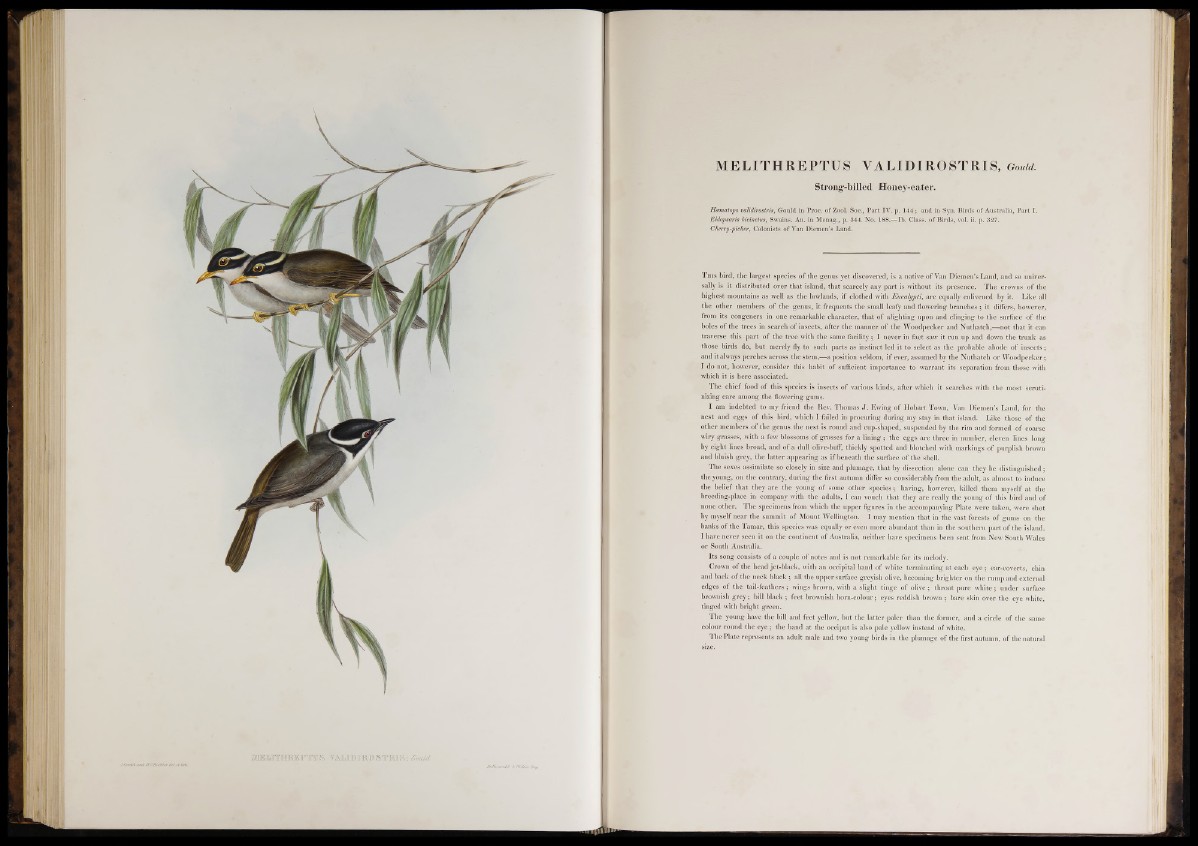
MEHTMBEIPTllT®> VAJL1LP \ M«iS
MELITHREPTUS VALIDIROSTRIS, Gould.
Strong-billed Honey-eater.
Hcematops validirostris, Gould in Proc. of Zool. Soc., Part IV. p. 144 ; and in Syn. Birds of Australia, Part I.
Eidopsaris bicinctus, Swains. An. in Menag., p. 344. No. 188.—lb. Class, of Birds, vol. ii. p. 327.
Cherry-picker, Colonists of Van Diemen’s Land.
T h is bird, the largest species of the genus yet discovered, is a native of Van Diemen’s Land, and so universally
is it distributed over that island, that scarcely any part is without its presence. The crowns o f the
highest mountains as well as the lowlands, if clothed with Eucalypti, are equally enlivened by it. Like all
the other members of fhe genus, it frequents the small leafy and flowering branches ; it differs, however,
from its congeners in one remarkable character, that o f alighting upon and clinging to the surface of the
boles of the trees in search of insects, after the manner o f the Woodpecker and Nuthatch,—not that it can
traverse this part of the tree with the same facility; I never in fact saw it run up and down the trunk as
those birds do, but merely fly to such parts as instinct led it to select as the probable abode of insects;
and it always perches across the stem,—a position seldom, if ever, assumed by the Nuthatch or Woodpecker;
I do not, however, consider this habit of sufficient importance to warrant its separation from those with
which it is here associated.
The chief food of this species is insects of various kinds, after which it searches with the most scrutinizing
care among the flowering gums.
I am indebted to my friend the Rev. Thomas J. Ewing of Hobart Town, Van Diemen’s Land, for the
nest and eggs of this bird, which I failed in procuring during my stay in that island. Like those of the
other members o f the genus the nest is round and cup-shaped, suspended by the rim and formed o f coarse
wiry grasses, with a few blossoms o f grasses for a lining ; the eggs are three in number, eleven lines long
by eight lines broad, and o f a dull olive-buff, thickly spotted and blotched with markings of purplish brown
and bluish grey, the latter appearing as if beneath the surface of the shell.*®
The sexes assimilate so closely in size and plumage, that by dissection alone can they be distinguished;
the young, on the contrary, during the first autumn differ so considerably from the adult, as almost to induce
the belief that they are the young of some other species; having, however, killed them myself at the
breeding-place in company with the adults, I can vouch that they are really the young o f this bird and of
none other. The specimens from which the upper figures in the accompanying Plate were taken, were shot
by myself near the summit of Mount Wellington. I may mention that in the vast forests o f gums on the
banks of the Tamar, this species was equally or even more abundant than in the southern part of the island.
I have never seen it on the continent o f Australia, neither have specimens been sent from New South Wales
or South Australia.
Its song consists of a couple o f notes and is not remarkable for its melody.
Crown of the head jet-black, with an occipital band of white terminating at each ey e; ear-coverts, chin
and back of the neck black; all the upper surface greyish olive, becoming brighter on the rump and external
edges of the tail-feathers; wings brown, with a slight tinge o f olive; throat pure white; under surface
brownish grey; bill black ; feet brownish horn-colour; eyes reddish brown ; bare skin over the eye white,
tinged with bright green.
The young have the hill and feet yellow, but the latter paler than the former, and a circle o f the same
colour round the ey e; the band at the occiput is also pale yellow instead of white.
The Plate represents an adult male and two young birds in the plumage o f the first autumn, of the natural
size.